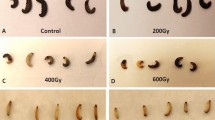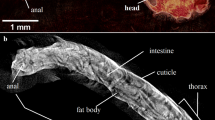Abstract
SEVERAL investigators have reported a dispersion of the concentrated red and yellow pigments in light-adapted species of Leander by injecting various tissue extracts. Panouse1 brought about a weak and slow dispersion by injecting extracts of “connectifs cérébro-œsophagiens”, an effect that was considered not to be hormonal. Sunesson2 announced similar results when extracts from the head of the isopod Idothea neglecta were used; but only one type of the chromatophores reacted in this way. Repeating these experiments, Carstam and Sunesson3 confirmed Sunesson's statement; but when extracts of the caudal segments were injected, the pigments of both types of chromatophores were clearly dispersed. The pigment movement, however, was different from the hormonally regulated pigment concentration in being slower, and a maximal effect was never obtained even if concentrated extracts were used.
This is a preview of subscription content, access via your institution
Access options
Subscribe to this journal
Receive 51 print issues and online access
$199.00 per year
only $3.90 per issue
Buy this article
- Purchase on Springer Link
- Instant access to full article PDF
Prices may be subject to local taxes which are calculated during checkout
Similar content being viewed by others
References
Ann. Inst. Océan., 23 (1946).
Lunds Universitets Årsskrift, N.F., 43, No. 5 (1947).
Kungl. Fysiografiska Sällskapets i Lund Förhandl., 19, No. 11 (1949).
Author information
Authors and Affiliations
Rights and permissions
About this article
Cite this article
CARSTAM, S. Enzymatic Inactivation of the Pigment Hormone of the Crustacean Sinus Gland. Nature 167, 321–322 (1951). https://doi.org/10.1038/167321b0
Issue Date:
DOI: https://doi.org/10.1038/167321b0
Comments
By submitting a comment you agree to abide by our Terms and Community Guidelines. If you find something abusive or that does not comply with our terms or guidelines please flag it as inappropriate.



